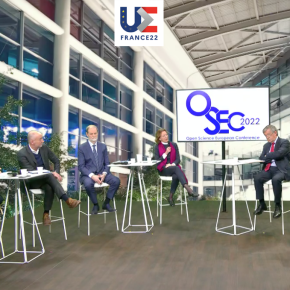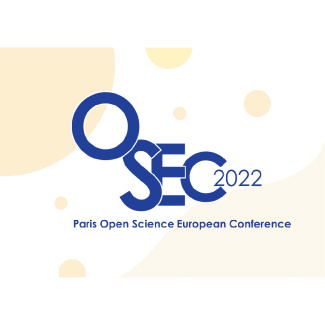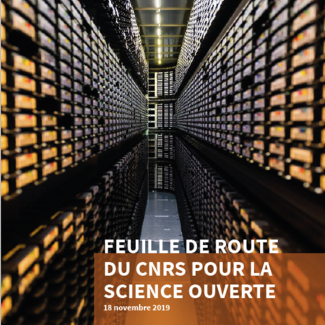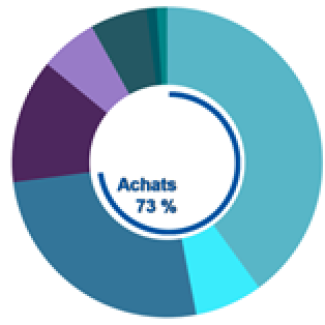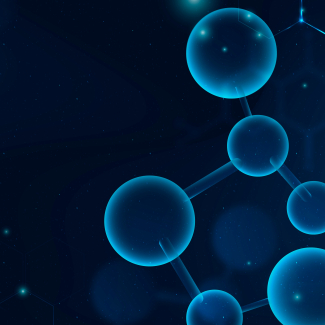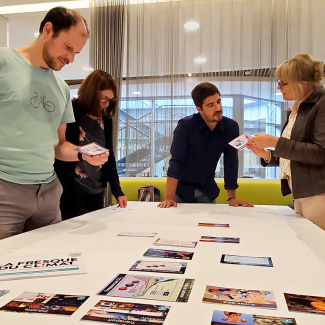OSEC 2022: open science at the European level
The Paris Call argues in favour of a reform of research assessment practices. It was presented at the Open Science European Conference (OSEC 2022) on February 4th and 5th 2022. This event was organised in the framework of the French Presidency of the Council of the European Union and also featured at the first Open Science Awards ceremony.
"In 2022, France aims to be an integral part of the open science movement and reinforce international momentum by giving it a new lease of life", says Marin Dacos, National Open Science Coordinator at the French Ministry of Higher Education, Research and Innovation (MESRI). The Open Science European Conference1 (OSEC 2022) held on February 4th and 5th 2022 attracted over 2000 online participants from all over the world and included the presentation of the Paris Call for Research Assessment Reform and the first Open Science Awards. This was the first of around ten events to be organised by the CNRS and its partners and approved by the MESRI in the framework of the French Presidency of the Council of the European Union (FPEU).
- 1The Open Science European Conference organised by the CNRS and the MESRI, the French Academy of Sciences, the National Institute of Health and Medical Research, the High Council for Evaluation of Research and Higher Education, the National Research Agency, the Université de Lorraine and the University of Nantes.
Open science involves opening up all aspects of the research process. It represents a challenge in terms of the transparency, reproducibility and influence of research, the aim being to accelerate and democratise research while enhancing its reliability and developing more collaboration. Open science brings up issues involving national and European power and is a priority for Europe, France (with the National Plan for Open Science in 2018 announced by the Minister Frédérique Vidal and updated in 2021 (French link), the CNRS (with its 2019 roadmap) and its G6 partners1 .
"The issues at stake go beyond national and European borders", said Antoine Petit, the CNRS Chairman and CEO when opening the event. OSEC 2022 was a global event attended by leading research figures including Mariya Gabriel, European Commissioner for Innovation, Research, Culture, Education and Youth, Maria Leptin, the new President of the European Research Council, the French Minister for Higher Education, Research and Innovation Frédérique Vidal and Claire Giry, director general for research and innovation at the MESRI. Representatives from Unesco and universities in the USA, Mexico and Argentina also attended.
The Paris Call for better research assessment
Open science was first developed by scientists themselves in the 1990s before gradually becoming part of public policy worldwide since the 2010s. In 2012, the European Commission published its recommendations "on access to and preservation of scientific information". The 2013 San Francisco Declaration on Research Assessment challenged the assumed correlation between a journal's reputation and the quality of a researcher's contributions to that journal. The Amsterdam Call for Action on Open Science was made during the Dutch Presidency of the Council of the EU in 2016. It put forward 12 actions to provide access to scientific publications and data resulting from publicly funded research and came in the same year as the French Digital Republic Law. At the end of 2021, the 193 countries taking part in UNESCO's General Conference adopted the first international framework recommendation on open science.
- 1The G6 network is made up of Europe's major multidisciplinary research organisations – the CNR (Italy), the CNRS (France), the CSIC (Spain), the Helmholtz Association, the Leibniz Association and the Max Planck Society (Germany) – and represents 135,000 employees.
Open science is progressing in France
The edition of the French Open Science Monitor published on 28 January 2022 revealed that 62% of the 166,000 French scientific publications published in 2020 were in open access by December 2021. This represented an increase of 10 points in one year which was similar to the increase observed for scientific publications from CNRS units in 2020 which went up to nearly 80% in open access. 46% of these French publications and 68% of CNRS publications are available on open archives like HAL1 which covers all disciplines. This is the main open archive used for French publications ahead of PubMed Central (biomedicine), arXiv (physics, mathematics and computer science) and bioRxiv (biology). Marked differences can be observed between disciplines but all of these archives are making progress in opening up publications. For the first time, the Open Science Monitor included a section focusing on health research which gave numerous indicators on the registration of clinical trials and their results.
Find out more: Open Science Monitor
- 1Developed by the Centre for Direct Scientific Communication (CNRS/Inria/Inrae).
The next step forward came with the Paris Call (French link) launched a few days before OSEC 2022 by the Committee for Open Science. It followed on from the European Commission's Call for expressions of interest which attracted over 160 signatures. France invited research organisations to join a coalition of European research stakeholders committed to implementing "operational, reciprocal and transparent transformations" in their research assessment practices. The idea is to make these practices fairer, more transparent and with greater recognition of the quality of research in all its diversity rather than of the quantity of a researcher's publications. Jean-Éric Paquet, Director-General of the European Commission's DG Research and Innovation Research and Innovation, considers research assessment is "the greatest challenge for open science" and that it is "crucial to its development and its integration within research establishments". Mr Paquet and several other European figures took part in a round table discussion on this subject, a core issue at OSEC 2022.
The many questions surrounding the evolution of research assessment in several disciplines and various frameworks thus took up a good part of the two days of the OSEC event. "The objective was to demonstrate that the research assessment system needs to be capable of adapting at all levels and to encourage best practices in open science, with coherent shared rules", explains Sylvie Rousset, director of the CNRS Open Research Data Department, who organised the OSEC 2022 event for the organisation.
It is essential to take proper account of the importance of scientists' work on publishing in open access, making their data accessible (French link) designing and maintaining software, making negative results available and so on. The CNRS is a driving force in this area (French link) and indeed defined evaluation as one of the 4 fundamental pillars of its Roadmap for Open Science. Sylvie Rousset stresses that the organisation is "fully" associated in the Paris Call and that "open science cannot be achieved without coordinating research assessment at all levels – local, national, European and international". The various accounts shared at OSEC 2022 went along with this way of looking at the issue.
Promoting bibliodiversity
The future of scientific publishing was also discussed in another session. This is a significant worldwide issue for knowledge sharing and stakeholders seem to be moving towards a combination of several access routes to open access publication. The National Plan for Open Science calls this 'bibliodiversity' which includes: pre-publications (the Covid-19 crisis clearly demonstrated its interest and limitations alike) (French link); open archives such as the French archive HAL (which just celebrated its 20th anniversary) (French link) with or without integrated or external peer review; and publications by scientific publishers with several models including diamond publishing1 . Marin Dacos explains that "finesse and balance are needed" in adapting to the requirements and cultures of different disciplines and making sure the disadvantages of certain approaches are offset by others. Again OSEC speakers' testimonies were similar on this point.
Finally, two sessions on more specific themes formed the conference's introduction and conclusion. The first focused on a specific discipline – health – which Marin Dacos described as "a condensed compilation of major societal, health and economic issues". The aim here was to situate debate firmly by basing it on a tangible case study of the use of open science to demonstrate its benefits for research and society alike. "Obvious and legitimate" reasons linked to the sensitive and private nature of individual data mean data limit the current sharing of data in the healthcare sector. However the Covid-19 pandemic clearly showed that such data are essential to the development of healthcare treatments and policies. In this area, then, open science is moving more towards controlled sharing and the possibility of making data circuits reliable than to broader total openness. For instance, tools are being developed to help scientists report on their research in a more reliable and accessible way. Another idea is that negative results should also be more widely published.
Open up all research products
OSEC 2022's final session focused on an "aspect of open science policy that remains greatly neglected", namely research software. Software is an essential building block in the transition from data to knowledge and yet it remains an invisible product of research with unequal levels of maintenance, citation and recognition. To rectify this state of affairs, Marin Dacos explains that "this issue needs to be worked on in depth" by looking at software as more than just data and taking the work involved and disciplinary specificities into account while keeping an open mind as regards the commercial exploitation of certain software. The second French National Plan for Open Science 2021-2024 led by the minister Frédérique Vidal puts a focus on this issue and the CNRS is supporting the development of Software Heritage, a permanent open free software archive.
The Open Science Awards were presented for the first time at the event and put software in the spotlight to recognise its value and contribution to science. This was a world first for this type of research contribution. The jury chaired by Daniel Le Berre, winner of the 2018 CNRS Innovation Medal for research software extensively used by industry (French link) awarded prizes for four software products, with a special mention for six others (see box) from a total of nearly 130 entries. Several of the winners shed light on the relative 'porosity' between the research and socio-economic spheres which requires research software to be free and open.
Marin Dacos concluded thus, paraphrasing a well-known metaphor: "Open science means scientists can truly sit on the shoulders of the giants that preceded them, shoulders that are stable and complete thanks to the inclusion of publications along with data and software". However he admits that "a great deal is still to be done", citing all the forms of research output that remain under-recognised but observes that "the FPEU will have given new energy to the movement to bring about these essential transformations throughout the entire research ecosystem".
- 1'Diamond' open access journals propose peer reviewing at no direct cost to authors and readers. A conference on this subject took place on February 2nd, just before OSEC 2022.
The 2022 Open Science Awards
The 'research data' and 'open research software' open science awards were an idea set out in the MESRI's second National Plan for Open Science and the latter were awarded for the first time in 2022 in recognition of emblematic initiatives in this area. The 'research data' awards for the "exemplary and innovative nature" of practices implemented to prepare and re-use all types of data will be presented in the summer of 2023. A thesis prize will also be launched in 2023.
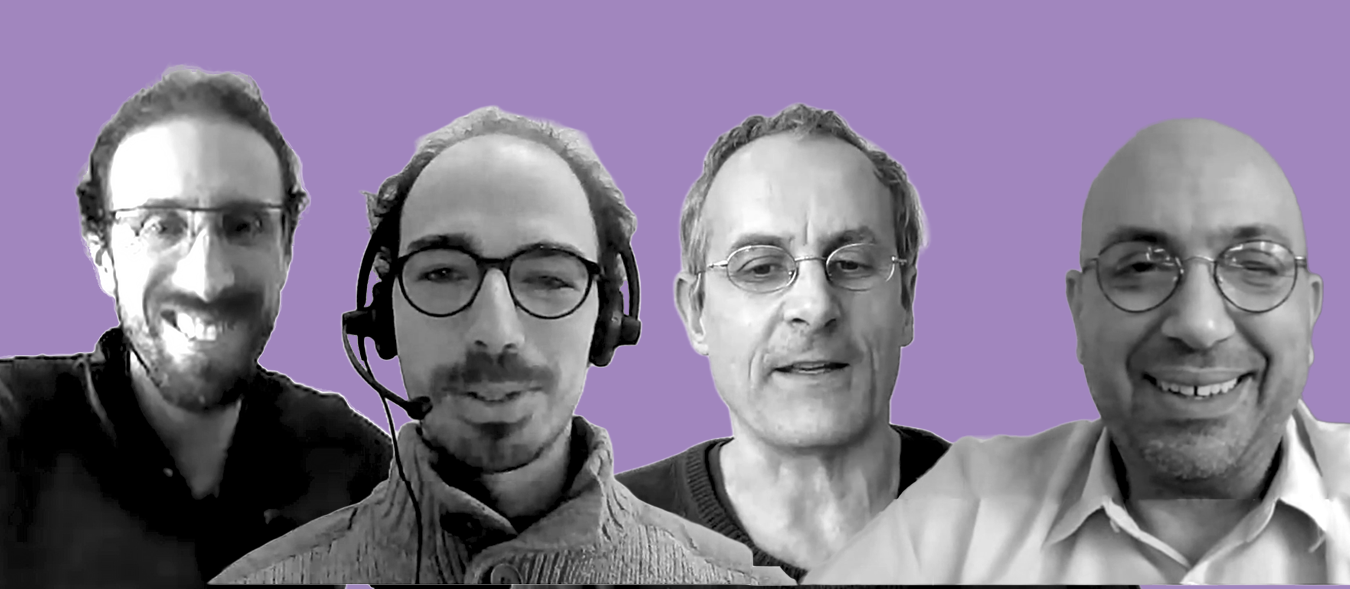
Open science award for free software
- Scientific and technical category:
- The Coq Proof Assistant (French link) developed at the National Institute for Research in Computer Science and Control (Inria) since 1984 to write and check mathematical proofs and its community created to ensure the software's long-term maintenance and progressive evolution – represented by Théo Zimmermann from the Institut de Recherche en Informatique Fondamentale (CNRS/Université de Paris).
- Special mention for the Coriolis software (French link) for computer-aided design in the field of silicon electronics, particularly for 'placement-routing'. The latter concept refers to the automatic placement and connection of the various parts of an electronic circuit according to the targeted programme – represented by Jean-Paul Chaput from LIP6 (CNRS/Sorbonne University).
- Community category:
- The scikit-learn open-source library which is coded in Python and widely used in the academic world and in a variety of companies. This tool provides turnkey algorithms to make data analysis and the use of machine learning easier – represented by Gaël Varoquaux, a researcher at the Inria
- Special mention for the Vidjil software platform for analysing DNA sequences from white blood cells. This platform has been developed since 2011 and is used by around forty national and international laboratories to diagnose and monitor leukaemia – represented by Mathieu Giraud from the Lille Research Centre in Computer Science, Signal and Automatic Control (CNRS/Centrale Lille/University of Lille).
- Special mention for the WebObs system which provides a set of tools under open licences and a unique web interface for integrated, centralised and automated real-time monitoring of natural phenomena like volcanoes and seismic risks – represented by François Beauducel from the Institut de Physique du Globe de Paris (CNRS/IPGP joint research unit).
- Documentation category:
- The FAUST programming language (French link) dedicated to digital audio signal processing and sound synthesis, particularly designing synthesizers, musical instruments and audio effects – represented by Stéphane Letz from GRAME, Lyon's national centre for musical creation.
- Special mention for the OpenViBE software platform (French link) which uses real-time processing of brain data to facilitate the design, testing and use of brain-computer interfaces. It also has particularly exhaustive documentation adapted to the user profile or hardware used – represented by Fabien Lotte, Inria researcher.
- The Jury Prize in recognition of an exemplary project that effectively combines technical components, community development and documentation:
- The Gammapy software analysis package for astrophysical data from telescopes. Gammapy has been developed since 2014 and has become a standard tool for processing astrophysical data. It is used, for example by the Cherenkov Telescope Array to analyse its open data and by NASA – represented by Bruno Khélifi from the AstroParticle and Cosmology laboratory (CNRS/University of Paris).
- Special mention for the GAMA simulation platform developed by a consortium of academic and industrial partners since 2010. It features a modelling and simulation development environment for the creation of agent-based models and the exploration of emerging phenomena in many scientific disciplines – represented by Alexis Drogoul, IRD researcher.
- Special mention for the Sppas tool for the automatic annotation of oral corpora. This also provides assistance with the analysis of these annotations. This software is dedicated to computational linguistics and corpus linguistics, independently of the language used. This software is maintained by a CNRS section 7 researcher in the purest spirit of free software. The jury wanted to spotlight this software with an award in the Jury Prize category – represented by Brigitte Bigi from the Speech and Language Laboratory (CNRS/Aix-Marseille University).
